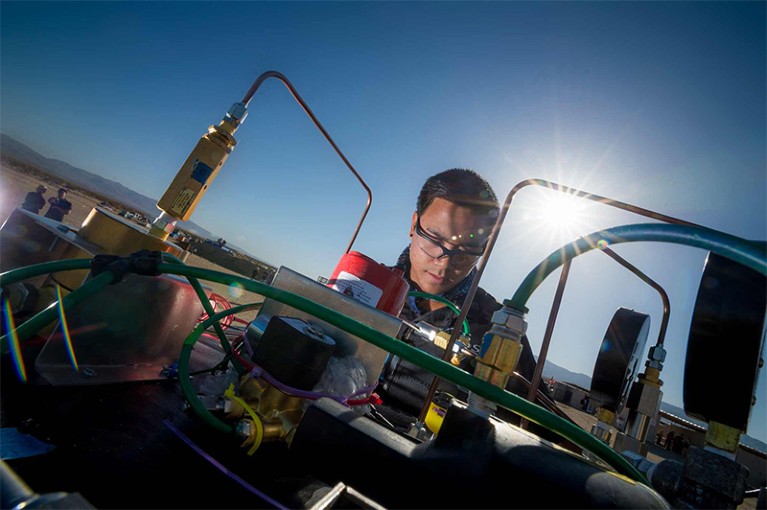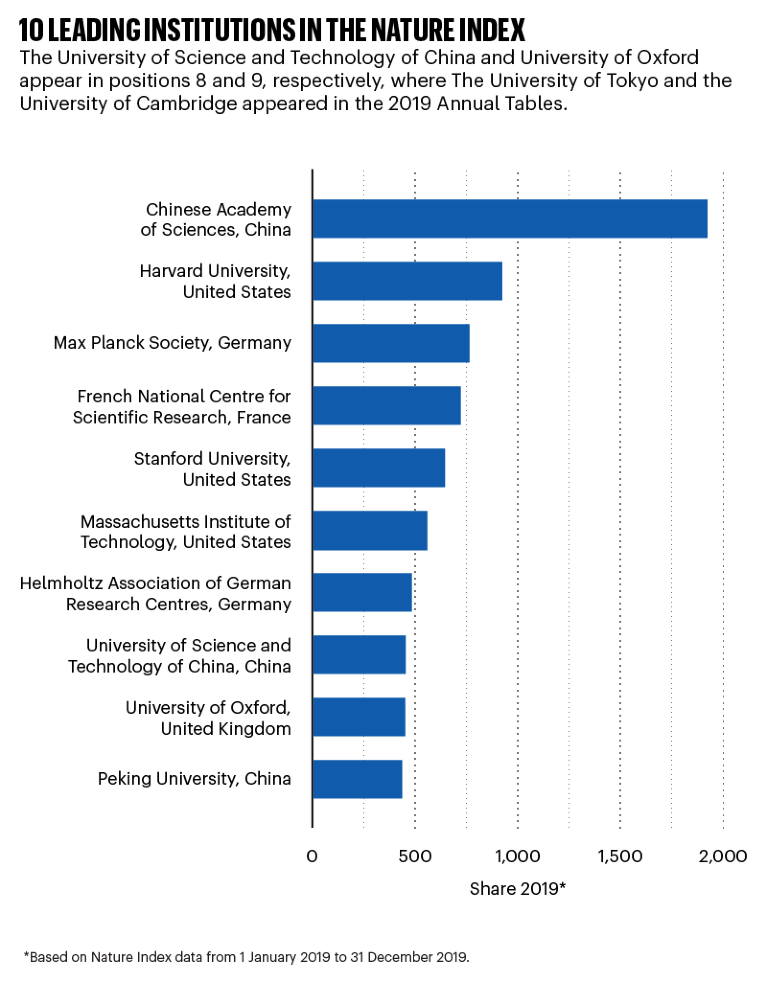
A researcher at the University of California, San Diego, prepares to launch a 3D-printed rocket.Credit: Erik Jepsen/UC San Diego
The Chinese Academy of Sciences (CAS) in Beijing has topped the Nature Index 2020 Annual Tables list as the most prolific producer of research published in the 82 selected journals tracked by the Index (see Graphic).
CAS’s Share of 1805.22 in 2019 was almost twice that of Harvard University in Cambridge, Massachusetts, which came in second. Research institutions from China, the United States, France, Germany and the United Kingdom feature among the ten most prolific institutions in the Index. See the 2020 Annual Tables Top 100 research institutions for 2019.
(Share, formerly referred to in the Nature Index as Fractional Count (FC), is a measure of an entity’s contribution to articles in the 82 journals tracked by the index, calculated according to the proportion of its affiliated authors on an article relative to all authors on the article. When comparing data over time, Share values are adjusted to 2019 levels to account for the small annual variation in the total number of articles in the Nature Index journals. The Nature Index is one indicator of institutional research performance. See Editor’s note below.)

Source: Nature Index
Here is a selection of institutions from the top 25 of the Nature Index 2020 Annual Tables.
University of Science and Technology of China
Share: 455.82; Count: 1,231; Change in adjusted Share (2018–19): +25.6%; Place: 8th
Established by the Chinese Academy of Sciences (CAS) in 1958 in Beijing (then known as Peking), the University of Science and Technology of China (USTC) moved to its current location in Hefei, the capital of the eastern Chinese province of Anhui, in 1970.
Today, it employs about 16,000 students, including 1,900 PhD students, as well as 1,812 faculty members, 547 of which are professors.
Nature Index 2020 Annual Tables
The institution’s strongest subjects in the Nature Index are chemistry and physical sciences. USTC is a global collaborator, counting the Max Planck Society in Munich, Germany, the University of Oxford, UK, and Stanford University in California among its close partners.
In 2019, USTC researchers were part of an international team that discovered a stellar black hole with a mass 70 times greater than that of the Sun. The findings, published in Nature, were mentioned in more than 300 tweets and nearly 200 news stories, according to Altmetric.
University of Michigan, United States
Share: 343.45; Count: 939; Change in adjusted Share (2018–19): −3.3%; Place: 19th
Placed first among public universities in the United States for research volume, according to the US National Science Foundation, the University of Michigan in Ann Arbor encompasses 260,000 square metres of lab space, which is accessed by students and staff in 227 centres and institutes across its campus.
With US$1.62 billion in research expenditure and more than 500 new invention reports in the fiscal year 2019, the University of Michigan is focused on innovative areas in research, including data science, precision health and bioscience. Its Global CO2 Initiative, launched in 2018, aims to identify and pursue commercially sustainable approaches that reduce atmospheric CO2 levels by 4 gigatons per year.
A 2019 study published in Science on honesty and selfishness across cultures, led by behavioural economist Alain Cohn, was covered by almost 300 online news outlets and reached more than 22 million people on Twitter, according to Altmetric. The study, which tested people’s willingness to return a dummy lost wallet, revealed a ‘high level’ of civic honesty.
University of California, San Diego, United States
Share: 340.85; Count: 1,048; Change in adjusted Share (2018–19): −1.2%; Place: 20th
With US$1.35 billion in annual research funding, the University of California, San Diego, is a force in natural-sciences research, particularly in oceanography and the life sciences.
Its health-sciences group, which includes the School of Medicine and Skaggs School of Pharmacy and Pharmaceutical Sciences, brought in US$761 million in research funding in the fiscal year 2019, and Scripps Oceanography, one of the world’s oldest and largest centres for research in ocean and Earth science, won $180 million in funding.
The university also has a focus on innovation, with more than 2,500 active inventions, 1,870 US and foreign patents, and 31 start-ups launched in 2018 by faculty members, students and staff. One such start-up was CavoGene LifeSciences, which aims to develop gene therapies to treat neurodegenerative disease.
Zhejiang University, China
Share: 329.82; Count: 815; Change in adjusted Share (2018–19): +10.5%; Place: 23rd
Zhejiang University in Hangzhou, China, is part of the Chinese government’s Double First Class Plan, which aims to develop several world-class universities by 2050. It employs 3,741 full-time faculty members and partners with nearly 200 institutions around the world.
Zhejiang’s total research funding reached 4.56 billion yuan (US$644 million) in 2018, with 926 projects supported by the Chinese National Natural Science Fund and 1,838 Chinese invention patents issued. The university is home to materials scientist Dawei Di, who was listed as a top innovator under 35 by MIT Technology Review in 2019 for his work on organic light-emitting diodes and perovskite light-emitting diodes.
In 2019, Zheijiang researchers published a Science paper with an international team that proposed a method for boosting plant growth while reducing water use, which could contribute to more sustainable agriculture practices.
Northwestern University, United States
Share: 317.12; Count: 762; Change in adjusted Share (2018–19): −7.6%; Place: 25th
Founded as a private research university in 1851, Northwestern University, based in Evanston, Illinois, now also has campuses in Chicago and Doha, Qatar, and employs 3,300 full-time research staff. It has an annual budget of US$2 billion and attracts more than US$700 million for sponsored research each year.
The fastest-rising institution in the United States in high-quality life-sciences research output, Northwestern University was also 14th in the world in chemistry in the Nature Index 2020 Annual Tables.
Its star researchers include mathematician Emmy Murphy, one of six recipients of the 2020 New Horizons Prize for her work in the field of topology — the study of geometric properties and relationships — and physicist John Joseph Carrasco and neuroscientist Andrew Miri, who in February were awarded prestigious Sloan Research Fellowships.

 Show of strength
Show of strength
 Fastest movers since 2015
Fastest movers since 2015
 Ten countries with high-performing hubs of natural-sciences research
Ten countries with high-performing hubs of natural-sciences research
 The ten leading countries in natural-sciences research
The ten leading countries in natural-sciences research
 Fast-rising research institutions 2020
Fast-rising research institutions 2020
 Fast-rising academic institutions 2020
Fast-rising academic institutions 2020
 Rising stars in life sciences 2020
Rising stars in life sciences 2020
 Rising stars in chemistry 2020
Rising stars in chemistry 2020
 Rising stars in physical sciences 2020
Rising stars in physical sciences 2020
 Rising stars in Earth and environmental sciences 2020
Rising stars in Earth and environmental sciences 2020








